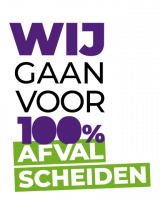Jan and Leni Grootscholten
"Separating waste is in our system"
For Jan and Leni Grootscholten from Dronten, separating waste is the most natural thing in the world. 'Your garbage bag stays empty much longer, so you don't have to walk to the underground waste container as often. That is the biggest advantage for us.'
The couple now only have to go to the underground container once a month. At home, Jan and Leni have their regular routine and know exactly what goes in which container. For example, plastic packaging material goes straight into a bag in the garage. 'There are just the two of us, but it's really unbelievable how much plastic waste we have. Let's stop wrapping everything in plastic!'
In the kitchen, they have two bins in a kitchen cabinet, one for residual waste and the other for vegetable, fruit and garden (GFT) waste in the container outside. 'When we clean vegetables while cooking, we put it straight into a separate bio bin that is on the kitchen counter. This makes you aware of the waste you are actually throwing away. Quite handy.'
Jan and Leni think it's important to separate waste as much as possible. 'If you throw everything together in one bin, you pollute the world very much. We don't want that. They also regularly clean up litter. Then you're amazed at how much garbage is left lying around on the streets. Especially around schools. Remarkably, we never come across anything with a deposit on it.

Buiting family
"Separating waste goes by itself"

Isabella and Johan Buiting have been aware of the environment and waste separation for years. They want to give that to their children Tygo, Lois and Kensi for later. Separating waste is normal for us. By incorporating it into our daily routine, it comes naturally.'
There is a bin for vegetable, fruit and garden (GFT) waste in the kitchen. That's where vegetable waste goes. 'I often make dinner from fresh vegetables. Soup, for example. It really saves a lot of waste when you make your own food.'
In the Buiting family's home, there are three other trash cans: one for paper, one for Plastic Cans and Drinks (PBD), and the last one is for residual waste. With the residual waste, they walk to the underground container about once a week. 'We are quite a large family, but by separating the waste properly we have much less waste. By letting the children grow up with it, we hope they will find it normal to do later.'
Separating waste can sometimes be confusing. I didn't know, for example, that (plastic) lids on glass jars can also go in the bottle bank. Or that some sauce containers cannot go in the plastic waste. By talking to each other and looking it up, we all come a long way!'
Federico and Isabelle Talen
"Also at school we separate waste"
Federico (10) and Isabella Talen (15) from Dronten make sure the garbage is neatly separated at home. Separation begins in the kitchen. Federico: ' There is a separate bag in the kitchen for plastic waste and a separate bin for green waste.' Isabella adds: 'We flatten large cardboard boxes and take them straight to the large paper container outside.'
The brother and sister advocate separating waste because it is better for the environment. 'It's important to reduce our impact on the environment, which we do by recycling. For example: if you recycle paper, you don't have to cut down as many trees! The generation after us also needs oxygen.' Separating waste starts at home, but continues at school. Isabella: 'At my secondary school there is a large plastic bottle, to collect plastic drinking bottles. Handy, because it allows you to see right away what you can throw in there.' Federico: "Sometimes it's not so easy to see in which container you can throw something away. For example, I learned that packaging, like a milk carton, is made up of plastic and cardboard. Now I know to take off the cap and put it with the plastic.' As a tip for peers, the two give: "When in doubt, don't do it. Ask your parents or the teacher before throwing away something you're not sure about. After all, no one likes rummaging through the garbage to find something!

Tips from waste coach Han
Tip 1
PBD is mainly household packaging material. So the plastic of meat products, the bread bag and the plastic packaging of vegetables.
Tip 2
Buy a trash can with three or four different compartments. For food waste (GFT), plastic, can and drink containers (PBD), residual waste and paper.
More tips?
Want more tips on separating trash? Collection employee Sander Spaan knows exactly what belongs in which bin.

